
A 2013 survey of 1,000 U.S. adults revealed that a disappointing 30% of them could name a living scientist. We shouldn’t take it too personally though, as a similar study revealed that the names of supreme court justices were just as elusive. This scientist survey has become popular again with a Twitter storm started by Dr. David Steen, an Assistant Research Professor at Auburn University who started the #actuallivingscientist movement. This has received amazing support from scientists summarizing their work in a single sentence and uploading a picture of themselves dressed the part, often in the field or lab. This is a timely call to action, and reemphasizes our responsibilities when it comes to disseminating the importance of our work to those who fund it.
The #actuallivingscientist movement should motivate scientists at all levels to rise to the occasion when they are next asked what they study, as an alternative to reducing their work, or uttering something similar to the title of this post. We constantly practice communicating our work to peers who understand the jargon, but how about explaining your experiments to a 10 (or 50) year old who doesn’t? As a graduate student, I frequently visited schools in Toronto, showing kids how to extract DNA from bananas and explaining the importance of model organism biology. This changed the way I communicated science. The clock was ticking like a bomb in a 007 movie; I had 30 seconds to tell them the most important aspects of any talk: “what is the question?” and “why should you care?”. Beyond memorizing facts and passing tests, getting kids excited about science is actually remarkably easy, they are naturally inquisitive. It is the job of all in the science sphere to nurture this innate quality in our future taxpayers and voters.
While big prizes such as the Nobel often grace the public sphere, recognition of few is not the solution. What if every year’s Nobel prize were presented in schools and to the public, not to highlight the people, but to highlight the process that led to the discovery? What were the researchers interested in? What fundamentals first had to be discovered to solve that problem? How did they do it? What did it mean for the scientific community and the world? In the end, perhaps the names are secondary. It is really the process that we value as scientists, the approach to discovery, and the value of evidence based decision making.
Hi, my name is Joe. I’m an #actuallivingscientist I study how single-celled microbes protect themselves from nasty viruses. @joebondydenomy